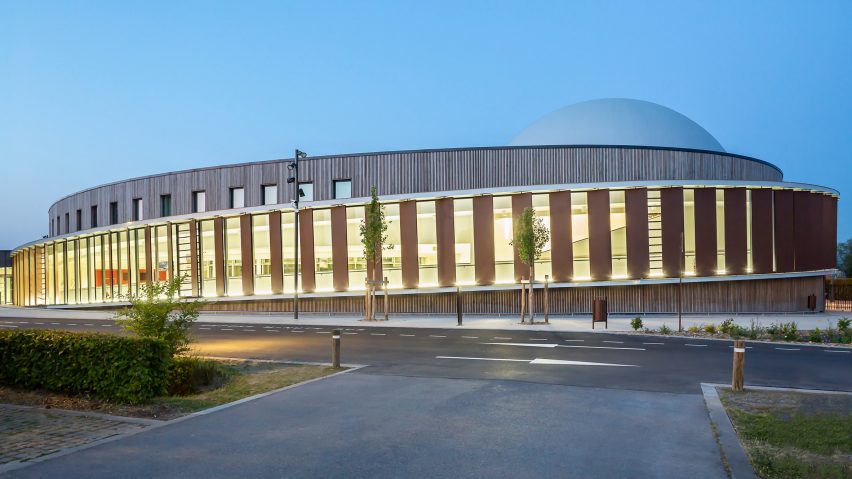Architecture studio Snøhetta has completed Orionis, a planetarium in Douai, France, that features two domes surrounded by sweeping wooden walls.
The planetarium, which is located in northern France, was made from materials informed by the surrounding area.
Its elliptical shape is comprised of a wall made from poplar wood and a glazed wall with steel brise-soleils. These draw on the architecture of the nearby Arkéos archaeology museum, with which Orionis shares its parking lots and landscaped areas.
The shape of the 2,000-square-metre building was informed by its function as a space where visitors can explore the night sky.
"We wanted to propose an extraordinary meeting place and a new destination for the inhabitants of Douai," said Snøhetta co-founder Kjetil Trædal Thorsen.
"The architectural and urban concept of our project takes its inspiration from the elliptical movement of the stars," he added.
"Being continuous, fluid and perpetual are notions that we have reinterpreted in the project, not only in terms of the shape but also in the experience that visitors will have of the planetarium, all senses employed."
The planetarium, which opened to the public in May, houses a reception area, exhibition spaces and an amphitheatre. It features two domes, which are covered in PVC and house the building's screening and projection rooms.
These can be seen from afar and were designed as a way of showcasing the planetarium's function through its shape.
A slightly inclined ramp links the different parts of the planetarium, which holds an elliptical courtyard at its centre.
This features a planted garden that can be seen from the rest of the building through the surrounding glass walls.
Snøhetta worked with engineering consultants CET Ingénierie, Impact Conseil et Ingénierie and Cicanord and acoustical consultant Studio Dap on the project.
The studio also collaborated with landscape company Atelier Silva Landscaping to optimise the surrounding landscape to "promote biodiversity".
Inside, the building was designed to create a sense of "coherence and continuity", with visitors following a circuit that leads from the entrance to an immersive room.
A ramp then brings them down to the ground floor and exit.
The building also houses an observatory area and offices on the first floor.
Snøhetta designed the project with some sustainable features, with its heating coming from geothermal energy and sensors installed on openings to provide "intelligent natural ventilation".
The planetarium's lower level has a green roof planted with wild grass.
The studio also used locally sourced materials and added sunshades to help regulate the temperature of the building.
Orionis marks one of the first projects that was completely conceived, managed and built by Snøhetta's Paris studio.
"We are extremely excited to showcase the Snøhetta approach for delivering high-quality cultural and educational buildings in France," said Oliver Page, managing director of Snøhetta's Paris studio.
Other recent projects by Snøhetta include a shingle-clad viewing tower in Austria and a cavernous climbing centre in Norway.
In the US, workers at the company's offices recently voted down a motion to unionise.
The photography is by Jad Sylla.

